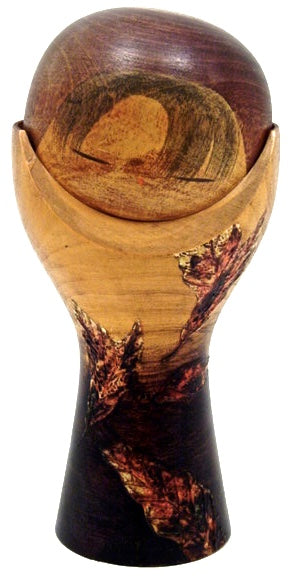

Vintage Sosaku Kokeshi entitled: “Donguri noyado | Acorn Girl” by Watanabe, Masao |1917-2007
All our items ship free in the US
Dimensions: 10-1/2”h
The figure shown has an unusual approach in that the head is cradled on the top of a lathe-turned Kimono/base. The base of the piece is hand-painted in full color in relief to represent acorn leaves in the fall. “Donguri no seikurabe” is a Japanese proverb meaning, “comparing the height of an acorn”, and refers to the belief that, “there being little to choose from between them for they are all alike”. This Kokeshi is not at all common in its turning or decorative treatment. Her face is typical of a young girl with a slight wisp of hair falling over her forehead using a sumi-e’ technique and showing ‘one-stroke eyes’, (Hitofude-me) and a red nose. There is a full inscription/name of the piece, impressed stamp, and artist's signature.
Condition: Excellent, perfect condition, and commensurate with age with wonderful workmanship, turning, and painted features. The piece meets all the standards of collectible Folk Art.
Return Policy
Our antique/vintage pieces are identified/described and professionally photographed, and considered, “as is”, therefore all sales are final. Read our full refund and return policy.
Artisan | Woodworker: Watanabe, Masao | 1917-2007
Origin:
Masao Watanabe | 1917-2007 (89)
Born in Fukushima, Watanabe-san studied under Traditional Yajirou Master Sato, Tatsuo of Miyagi Prefecture. Arguably, the most popular and prolific of the 20th/c Sosaku Kokeshi artists, he began his craft in the early 1950s. His most famous Kokeshi themes are that of ‘innocence’ (Mushin), and his doll entitled: Chigo Zakura (Cherry Blossom Child). A multiple award winner in Kokeshi competitions around the world (Prime Minister's prizes for the works of "Chigozskura" in 1963 and "Shojo" in 1981), along with numerous prizes by the Modern Kokeshi Artist Association and JETRO. He held two exhibitions in Japan and was exempt from the examination of the All Japan Kokeshi Contest, a Member of the Nippon Kokeshi Artistic Handicraft Association. His works are permanently exhibited at the Nuremberg Toy Museum in Germany.

Collector's note – descriptive qualities, standard characteristics & ornamentation styles:
Of all the Kokeshi produced by Masao Watanabe, his doll entitled, Mushin, (Innocence), is the most representative of this artist’s work. The emphasis is on the color of the natural wood and texture, and the form of this piece is the most recognizable of all of his dolls. The representation of clothing, complemented by the natural graining of the wood, and the painting of the sash, is common for this particular series. The natural wood implies the kimono or yukata with Its smooth curves brought about through the use of the lathe. Some painted and raised forms to resemble Shibori, a type of tie-dyeing that give texture to the garment. He also prominently features the rose and camellia as a central motif. His most famous piece above, is entitled, ‘Chigo Zakura’, (Cherry Blossom Child), which won the Prime Minister’s Award, and was presented to the Beatles in 1965, after their appearance in Japan with Sir Joseph Lockwood, Chairman of EMI Record Distributors, England.
Artist's Signature:



